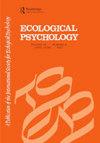The Role of Perception–Action Systems in the Development of Tool-Using Skill
IF 1.8
3区 心理学
Q3 PSYCHOLOGY, EXPERIMENTAL
引用次数: 6
Abstract
ABSTRACT Gaining proficiency using tools during childhood is an important accomplishment and involves using the hands to perceive tool properties and perform goal-directed actions. Using a perception–action perspective, we explored (a) whether tool characteristics (inertia) influence perceptual judgments and hammering action performance and (b) developmental changes in perception and performance. Adults and preschool children completed a hammering performance task and a forced choice perceptual task in which they judged which of 2 hammers was more effective. In the performance task, we found that the number of pegs hammered increased developmentally and changed as a function inertial characteristics, with more pegs hammered for hammers weighted in the head. Period of hammering movements was modified to compensate for inertial characteristics and movement variability decreased developmentally. In the perceptual task, we found inertial characteristics influenced perceptual judgments and attunement to this information increased developmentally. In addition, we found measures of perception and performance were related. These findings provide evidence that perception and action are coupled and changes in one are associated with changes in the other during development.感知-行动系统在工具使用技能发展中的作用
在儿童时期熟练使用工具是一项重要的成就,包括使用手来感知工具的特性和执行目标导向的动作。使用感知-行动视角,我们探讨了(a)工具特性(惯性)是否影响感知判断和锤击动作表现,以及(b)感知和表现的发展变化。成人和学龄前儿童分别完成了一个锤子表演任务和一个强迫选择知觉任务,在这个任务中,他们判断两种锤子中哪一种更有效。在性能任务中,我们发现锤击钉的数量随着发展而增加,并随着惯性特性的变化而变化,锤头加权锤击钉的数量更多。修正了锤击运动周期,以补偿惯性特性和运动变异性的发展。在感知任务中,我们发现惯性特征影响感知判断,并且对这些信息的调谐随着发育而增加。此外,我们发现感知和表现的测量是相关的。这些发现提供了证据,证明在发育过程中,感知和行动是耦合的,其中一种的变化与另一种的变化是相关的。
本文章由计算机程序翻译,如有差异,请以英文原文为准。
求助全文
约1分钟内获得全文
求助全文
来源期刊

Ecological Psychology
PSYCHOLOGY, EXPERIMENTAL-
CiteScore
3.30
自引率
10.50%
发文量
8
期刊介绍:
This unique journal publishes original articles that contribute to the understanding of psychological and behavioral processes as they occur within the ecological constraints of animal-environment systems. It focuses on problems of perception, action, cognition, communication, learning, development, and evolution in all species, to the extent that those problems derive from a consideration of whole animal-environment systems, rather than animals or their environments in isolation from each other. Significant contributions may come from such diverse fields as human experimental psychology, developmental/social psychology, animal behavior, human factors, fine arts, communication, computer science, philosophy, physical education and therapy, speech and hearing, and vision research.
 求助内容:
求助内容: 应助结果提醒方式:
应助结果提醒方式:


